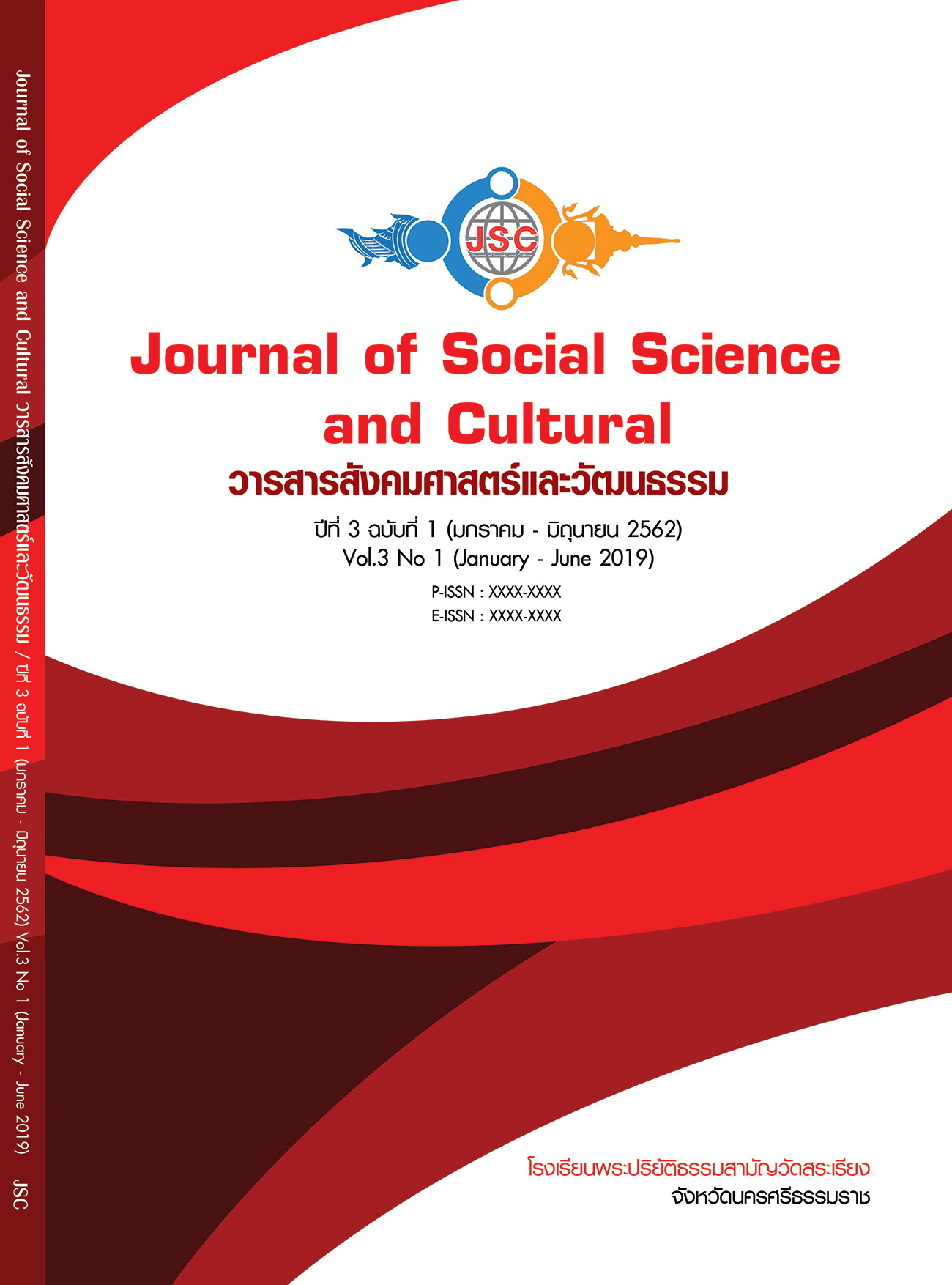THE FACTORS AFFECTING DEVELOPMENT FOR THE QUALITY LIFE OF THE DISABLED IN KOMPANGSOA SUBDISTRICT ADMINISTRATIVE ORGANINZATION MUEANG DISTRICT NAKHON SI THAMMARAT PROVINCE
Main Article Content
Abstract
The purposes of this study were as follows: 1) to study of life quality development of disables 2) to compare on life quality development of disables and 3) to study suggestions and ways to improve the quality of life of the disabled. The study was quantitative research by specific sampling questionnaire from the group sample of disables who working age between 25 - 50 year-olds and living at Kampangsoa sub district administrative organization, Mueang district, Nakhon Si Thammarat province more than 10 years with the total 183 persons. Data were analyzed using (Krejcie and Morgan formula), statistic, percentage, average, standard deviation, t - test and F - test for presenting descriptive information in an overview. The findings were as follows: 1) The life quality development of disables found overall is at a medium level so divided into 4 parts such as 1.1) mind 1.2) health 1.3) environment and 1.4) social relationship 2) The comparative results on life quality development of disables that have different life in terms of gender, age, disable type and occupation so the life quality of disables are the same. And is associated with a statisticant significant level .001. 3) The study suggests about the life quality development of disables 3.1) there should have more service providing at home according to basic right of disables. 3.2) There should promote information into public relations that will useful for disabled. 3.3) There should support full time and part time job to disables in community 3.4) There should help disables to rehabilitation for living quality with basic need and 3.5) there should training skill for the staff or volunteer to take care the disables.
Article Details
References
เฉลิมขวัญ สิงห์วี. (2548). ปัจจัยที่ส่งผลต่อคุณภาพชีวิตของคนพิการทางกายในศูนย์ฟื้นฟูอาชีพคนพิการในเขตกรุงเทพมหานครและปริมณฑล. ใน วิทยานืพนธ์วิทยาศาสตรมหาบัณฑิต สาขาจิตวิทยาชุมชน. มหาวิทยาลัยเกษตรศาสตร์.
ธิดารัตน์ นงค์ทอง และพิมพา ขจรธรรม. (2560). การศึกษาคุณภาพชีวิตของคนพิการรุนแรงทางร่างกายและการเคลื่อนไหว. วารสารพัฒนาสังคม, 19(2), 113-131.
บุญชม ศรีสะอาด. (2556). วิธีการทางสถิติสำหรับการวิจัย เล่ม 1. (พิมพ์ครั้งที่ 5). กรุงเทพมหานคร: สุวีริยาการพิมพ์.
วิชุพรรณ ทินนบุตรา. (2559). แนวทางการพัฒนาคุณภาพชีวิตของคนพิการที่ใช้รถเข็น ในเขตกรุงเทพมหานครและปริมณฑล. วารสารมหาวิทยาลัยพายัพ, 26(1), 207-232.
ศศินันท์ วาสิน. (2556). ปัจจัยที่มีผลต่อคุณภาพชีวิตคนพิการในจังหวัดนนทบุรี. วารสารบัณฑิตศึกษา มหาวิทยาลัยราชภัฏวไลยอลงกรณ์ในพระบรมราชูปถัมภ์, 7(2), 83-96.
สำนักงานพัฒนาสังคมและความมั่นคงของมนุษย์จังหวัดนครศรีธรรมราช. (2559). ข้อมูลคนพิการในเขตองค์การบริหารส่วนตำบลกำแพงเซา อำเภอเมือง จังหวัดนครศรีธรรมราช. นครศรีธรรมราช: องค์การบริหารส่วนตำบลกำแพงเซา.
สำนักงานสถิติจังหวัดนครศรีธรรมราช. (2558). ข้อมูลประชากรคนพิการ. เรียกใช้เมื่อ 25 มิถุนายน 2559 จาก http://nksitham.nso.go.th/index.php? option=com _content&view=article&id=397:mindmap-older&catid=100 :2012-01-09-07-04-24
สุจินต์ สว่างศรี. (2550). การส่งเสริมอาชีพคนพิการทางสติปัญญาของโรงเรียนลพบุรีปัญญานุกูล จังหวัดลพบุรี. ใน โครงการวิจัยตามแผนงานสร้างเสริมสุขภาพคนพิการในสังคมไทย. สถาบันวิจัยระบบสาธารณสุข.
Cronbach, L. J. (1990). Essentials of psychological testing. (5th ed.). New York: Harper Collins Publishers.
Krejcie, R. V. & Morgan, D. W. (1970). Determining Sample Size for Research Activities. Educational and Psychological Measurement, 30(3). 607-610.
Likert, R. (1967). The Method of Constructing and Attitude Scale. In Fishbeic, M (Ed.), Attitude Theory and Measurement (pp. 90-95). New York: Wiley & Son.


